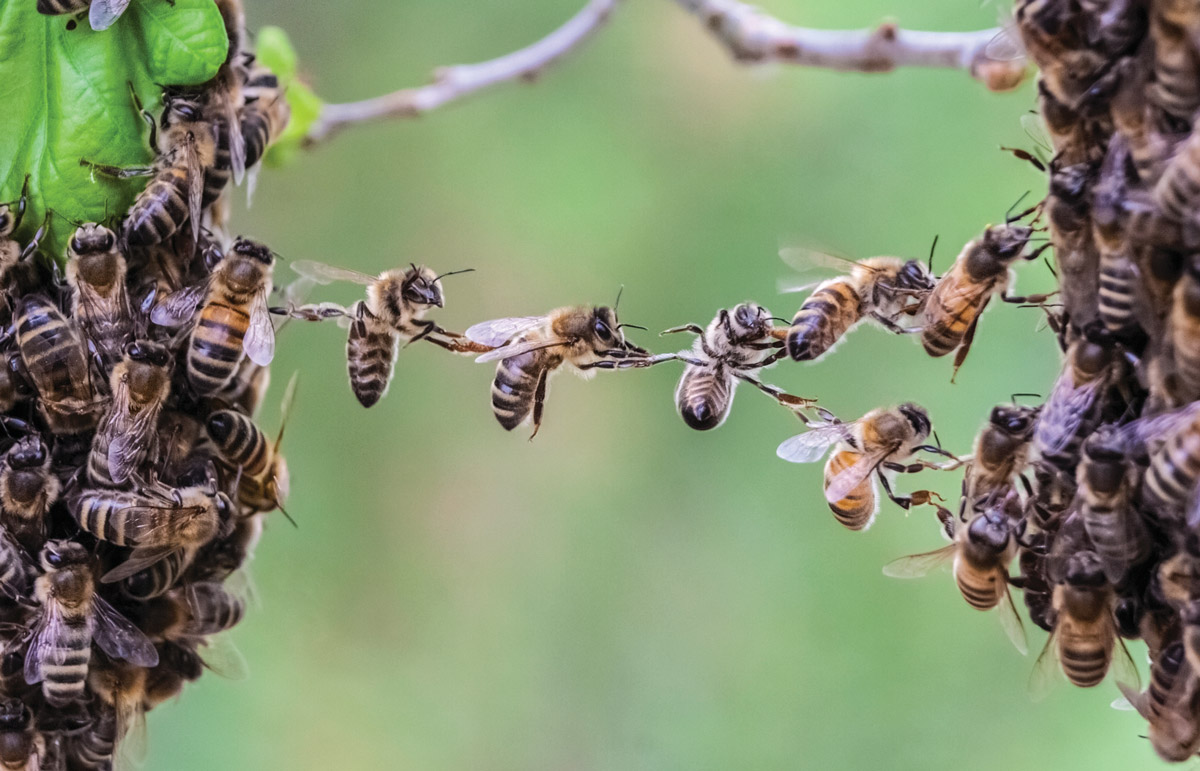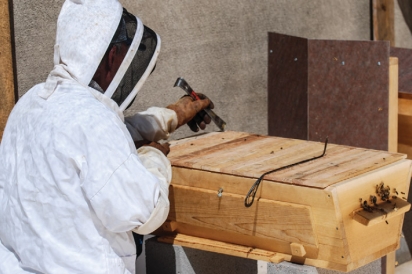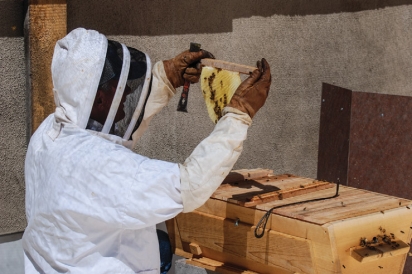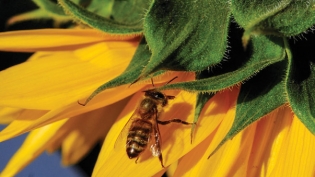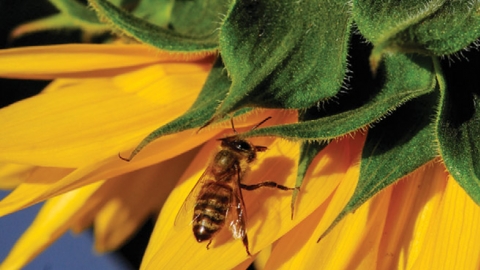Hive Mind
Robert Bailey is on a mission to save the Roaring Fork Valley’s feral bee population, one swarm at a time
“They’re not my bees,” Robert Bailey corrects himself with a lopsided smile, before taking a sip of his tea. “They’re our bees.” We’re at Town, Chef Mark Fischer’s restaurant in Carbondale, discussing Bailey’s circuitous path from general contractor to “bee guardian.” Above us are two rooftop hives constructed by Bailey, part of Town’s mission to “do its small part in providing a good home for some bees,” says Fischer.
This isn’t a story about honey. “The focus on bees has always been, ‘What can we get from them?’ says Bailey. “The thinking should be, ‘What can we do for them?’ I have bees for the health of the planet.” Bailey’s raison d’etre is acting as “advocate for the safeguarding of honeybees—I want people to understand what purpose they serve.” Bailey—still a general contractor—rescues and relocates swarms of feral bees (insects descended from domestic species that live on their own in the wild) that have set up shop in people’s homes or other structures, or in backyard trees. After he collects the bees (a complex process that can involve dismantling parts of the structure), Bailey installs them in hives located throughout the Roaring Fork Valley.
Swarming is a natural process that occurs when a successfully thriving colony outgrows its hive. A “prime swarm,” says Bailey, is the first one that comes from a hive with the original queen and roughly half of the colony; this is often what you’ll find established in the eaves of your house or in a hollow tree.
Feral drones (males) can breed with domesticated (non-native) queens, which can bolster the genetic diversity or vigor of the colony, enabling them to better withstand environmental stressors. “The feral drones here are already acclimated to our region,” says Bailey, “whereas imported bees from, say, California, are adapted to a temperate climate with low altitude. Even within Colorado’s feral bee populations, plains bees are adapted to the plains.”
These desirable, feralbred bees have the stamina to survive the winter and other factors in this region, including high altitude, a short growing season and a limited indigenous food supply. Come spring, they’ll diversify the plant habitat in the valley via pollination. The average honeybee has a life expectancy of five to six weeks in the summer (four to five months in winter), but they can fly up to five miles to a single source of nectar.
The canary in the coal mine
The National Resource Defense Council estimates that “bees and other pollinators like birds, bats, beetles and butterflies are responsible for cross-pollinating at least 30 percent of the world’s agricultural crops.” While statistics vary amongst research and environmental organizations, there’s no disputing the crucial role honeybees play in both our food supply (including livestock fodder and soil-building crops) and the genetic diversity of plant species in general. “They’re the canary in the coal mine,” says Bailey.
Bees have dominated the headlines for over a decade, ever since Colony Collapse Disorder (CCD) was first documented in 2006. The National Pesticide Information Center reports that, “Beekeepers began reporting “high colony losses, where the adult honeybees simply disappeared from the hives, almost all at the same time.”
While researchers cite a variety of factors in CCD (pesticide/herbicide use, climate change, loss of habitat and pathogens like mites, etc.) many beekeepers and bee experts—including Bailey—find that it’s a more complex issue.
“What’s undeniable,” he says, “is that bee populations are dwindling worldwide. The worst thing that can happen for bees is for us to continue the same agricultural practices we’ve been using for the last 50 years. The way bees are treated isn’t helping, either.” What Bailey is referring to is the routine commercial practice of treating hives with pesticides to control a variety of issues, which results in resistant species not dissimilar to the superbugs creating havoc in human health.
Another factor, says Bailey, is monoculture agribusiness. “A monoculture is a single-species landscape and mismanagement of the planet; bees need a diversity of pollen and nectar sources, which are often wiped out with herbicides.”
By way of example, our local bees feed on dandelions, milkweed and thistles— plants that are considered invasive weeds. “Good property management is key to controlling these species, but you should also mulch and plant wildflowers to feed the local bee population,” says Bailey. He also recommends leaving some of those weeds on your property, and cutting or pulling them before they bolt, or go to seed (see sidebar, “Bolstering the local bee population”).
Making a business from—and for—bees
Bailey grew up on an Oregon wheat, alfalfa and cattle operation and has always had a fascination with bees and a respect for environmentally sound agriculture. “We never sprayed our crops, so I was aware from a young age that there were alternatives to using chemicals,” he recalls. He fell into his present occupation after a friend who knew he was informed about bees and did construction asked him to remove a feral colony from his home.
“I figured it was a simple task, and that I’d just need to re-create [the bees’] living space elsewhere,” says Bailey. Removing a hive from a neighbor’s home followed, and his side business grew from there. Despite his love of genus Apis, Bailey’s never had a desire to be a commercial beekeeper. “My passion is observing and saving bees. I also enjoy working with people and seeing the excitement they get learning about them— it’s priceless.”
When people call Bailey, he removes the errant bees, repairs any structural damage (he only charges for this service) and installs the colony in one of his custom-built top-bar hives. This frameless style allows bees to construct combs naturally, making for a less intrusive form of beekeeping and harvesting honey, because the entire hive isn’t exposed to the open air when the beekeeper checks on the insects.
Bailey usually doesn’t wear protective equipment or use smoke, preferring to let the colony’s comportment dictate how he should handle them. “There’s various factors that affect the behavior of bees, including the weather and your attitude,” he says. “If the [honey] flow is off, they also tend to get grumpy. You need to learn to read them.”
If the folks who call him prefer not to keep the bees once he has removed them, Bailey has no problem finding placement for his hives: Many Valley residents are eager to keep bees on their property purely for the observational pleasure the insects bring, and Bailey maintains the hives. Although honey isn’t the goal, what he’s able to collect after relocating bees “is the best. It’s usually divvied up between the homeowner and myself, except for what I put into the new hive for the bees to eat until they start foraging for themselves.”
Town isn’t the only local business keeping Bailey’s feral bees. Last May, Carbondale’s Marble Distilling Co. had Baily construct two hives on their rooftop. While it’s home for feral colonies, the company also plans to use the resulting honey for a limited-release vodka.
Says co-owner/head distiller Connie Baker, “Bob suggested we use the roof to grow the urban bee population. He so generously shares his knowledge and educates anyone who will listen—all to help the bees. He doesn’t seek anything other than sincerely wanting humans to take an active interest in protecting the species. Everything he’s taught us—and our children—is so simple to do, but we’d never before been told how to live symbiotically with bees.”
Bailey’s other bee-centric projects include writing a children’s book and working with local schools, educating students about honeybees. He’s also gearing up to release “Bee Grocery” beneficial seed packets, tailored to the tastes of the local pollinator population.
Bailey’s found his calling in saving bees, but—not unlike pollinators and plants—it’s a symbiotic relationship.
“I can have the worst day of my life, then go sit outside with the bees and turn it around,” he says, thoughtfully. “They’re happy just doing what they do—there’s so many life lessons to be learned from an insect.”
GO FIND IT!
For swarm removal/capture services or custom beehive construction or hive installation, email Robert Bailey at 1honeybeerescue@gmail.com.


